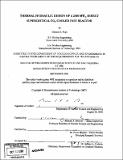Thermal hydraulic design of a 2400 MW t̳h̳ direct supercritical CO₂-cooled fast reactor
Author(s)
Pope, Michael A. (Michael Alexander)
DownloadFull printable version (16.84Mb)
Other Contributors
Massachusetts Institute of Technology. Dept. of Nuclear Science and Engineering.
Advisor
Michael J. Driscoll.
Terms of use
Metadata
Show full item recordAbstract
The gas cooled fast reactor (GFR) has received new attention as one of the basic concepts selected by the Generation-IV International Forum (GIF) for further investigation. Currently, the reference GFR is a helium-cooled direct cycle plant with core outlet temperatures in the 850"C to 10000C range. Pursued in the interest of high cycle efficiency and the provision of process heat for hydrogen production by thermochemical water cracking, these high temperatures present materials challenges which may prove difficult to overcome in the near future. By taking advantage of the low compressibility of CO2 near its critical point, the supercritical CO2 (S-CO2) recompression cycle can achieve an efficiency of 48% with a relatively low core outlet temperature of 650'C. The 4-loop 2400 MWth direct S-CO2 cooled fast reactor under investigation at MIT is thus a lower-temperature alternative to the mainstream helium cooled GFR design. A steady state core design was developed which utilizes an innovative, high fuel volume fraction, vented Tube-In-Duct (TID) fuel assembly. Through an extensive series of iterative calculations, RELAP5-3D was then used to evaluate the natural circulation performance of an active/passive hybrid Shutdown/Emergency Cooling System (SCS/ECS). Routes were identified by which significant post-LOCA core bypass could occur and degrade the decay heat removal performance. Moderately-sized blowers were shown to be capable of overcoming even extreme core bypass routes. An active SCS/ECS was thus adopted for the reference design. (cont.) The loss of external load (LOEL) event is analyzed and a bypass valve scheme is recommended which prevents shaft overspeed and excessive core coolant mass flow rate. A large dry pressurized water reactor (PWR) containment building having a free volume of 70,000 m3 and a peak design pressure of 6 bar is selected for this design based on a 100 in2 cold duct break. During this same loss of coolant accident (LOCA), the depressurization time is shown to be in excess of 10 minutes. No action need be taken by the SCS/ECS blowers before this time in order to prevent core damage. After this time, a total blower power less than 90 kW is sufficient to cool the core out to 10,000 seconds. A loss of flow (LOF) transient in which a PCS loop is instantaneously isolated and no mitigating action is taken (i.e. no reactor scram) is also shown not to cause core damage. It is concluded that a large S-CO2 cooled GFR coupled to a supercritical Brayton power conversion system can withstand the thermal hydraulic challenges posed by the usual menu of severe accident scenarios.
Description
Thesis (Ph. D.)--Massachusetts Institute of Technology, Dept. of Nuclear Science and Engineering, 2006. "September 2006." In title on t.p.,double-underscored letters "t" and "h" appear as subscript. Includes bibliographical references (p. 229-233).
Date issued
2006Department
Massachusetts Institute of Technology. Department of Nuclear Science and EngineeringPublisher
Massachusetts Institute of Technology
Keywords
Nuclear Science and Engineering.